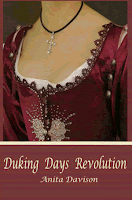
James Crofts, later James Scott, 1st Duke of Monmouth and 1st Duke of Buccleuch (April 9, 1649 – July 15, 1685)
Born in Rotterdam to Prince Charles, later Charles II and Lucy Walter. When Charles II was invited back to the throne, James Crofts was sent to live in Paris with the dowager Queen Henrietta Maria and Charles’ youngest sister Henriette Anne [Minette]
At fourteen, he was brought to Whitehall and treated like the heir to the throne He reputedly had an affair with Barbara Villiers before his father married him to Anna Scott, Duchess of Buccleuch, whose name he adopted.
Having been exiled to the continent for his part in the Popish Plot in 1683, Monmouth returned to England after his father’s death with eighty men intent on claiming the throne for a Protestant Monarchy. His march through the West country gathered 6,000 supporters at one point and he declared himself King in Taunton Market Place.
James II, Monmouth’s uncle sent John Churchill down to Somerset to rout the rebels and Monmouth’s army was defeated at Sedgemoor. Monmouth fled, but was caught and executed on 15th July 1685 at the age of 36.
John Wilmot, 2nd Earl of Rochester

A wit and poet at the court of Charles II, was quoted:
"the wildest and most fantastical odd man alive."
To help mend his depleted finances, the 18 year old Rochester abducted the heiress, Elizabeth Malet, snatching her from a coach from under the nose of her guardian, Lord Hawley. Rochester was pursued, arrested, and briefly imprisoned in the Tower of London, before begging and receiving the king's forgiveness. Shortly after her rescue, Elizabeth rejected other more wealthy suitors and married Rochester on January 29, 1667.
During the years that followed, the young earl lived a double life: at Adderbury, his country house in Oxfordshire, he enjoyed the forgiveness of his wife; at court he pursued a free-wheeling, scandalous life. Elizabeth Barry was not an obvious choice as a mistress. Her stage début in 1675 was unimpressive, and was said to be quite ugly. One wit wrote of her that she was,
'The finest woman in the world upon the stage and the ugliest woman oft on't.'
In 1677 Elizabeth gave birth to his daughter, also called Elizabeth. The affair ended and Rochester took his baby daughter out of Barry's care, but she died at about the age of 12. Rochester returned to his family and they spent a peaceful few years together, away from the court after his many years of over-indulgence. Husband and wife died within a year of each other in 1680 and 1681. During his last months, with his health in decline, Rochester developed an interest in philosophy and religion with Gilbert Burnet, royal chaplain and later Bishop of Salisbury. Rochester, at age 33, was a physical wreck. He had, in the words of the famous 18th century critic Dr. Samuel Johnson,
'Blazed out his youth and health in lavish voluptuousness'
When his son Charles, the 3rd earl, died on the 12th of November 1681, his titles became extinct.















